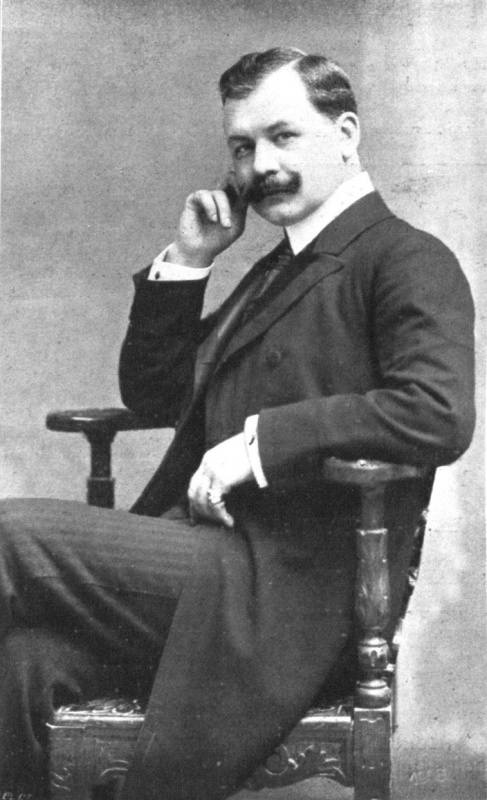
Ferenc Lehár in a photograph taken in 1906. /Source: Wikimedia Commons
Ferenc Lehár was a precursor of a new direction for the West European operetta. He managed to revive this genre, which began to fade after the end of its golden, initial period. The first decade of the twentieth century brought a true operetta revival hanks to the genius of this Hungarian composer, who shone at the height of his career. With each subsequent operetta, Lehár raised the musical spectacle to an ever higher level. Increasingly more wonderful, creative and sublime musical forms accompanied by an even more opulent orchestration meant that the Lehár operetta was a hit across the world's stages.
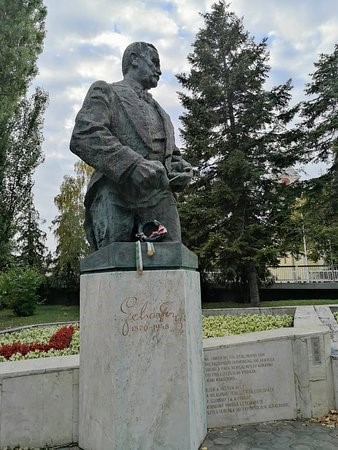
Monument to Ferenc Lehár in his home town. /Source: Wikimedia Commons
Ferenc Lehár was born on 30 April 1870 in the small town of Komárom in Hungary. Franz, bandmaster of the 50th Infantry Regiment, and Chrstine, a Hungarian, daughter of a veteran of the Hungarian uprising were his parents. He had three siblings: sister Maria and brothers Anton – later Major General C. K. Army and Edward. Ferenc demonstrated outstanding musical skills relatively early on. At the age of only six he composed a piece about his mother with a text very mature for his age. When he was nine years old, the regiment where his father served was moved to Budapest, and as a result the whole family moved there as well. After graduating from high school he entered the Conservatory in Prague. He studied violin with Anton Bennewitz, director of the Conservatory, and music theory with Josef Bohuslav Foerster, an outstanding Czech composer. After five years of tuition, Bennewitz took Lehár to Antonín Dvořák. The young Hungarian presented him with his compositions, including two sonatas, a scherzo and a capriccio. The Czech genius, realising Ferenc's talent, advised him to abandon playing the violin solo and focus on composing. The famous German composer Johannes Brahms was of a similar opinion. Lehár would probably have followed the advice of great composers, as he was considering changing his degree subject, but he listened to his father, who strongly advised him against it. After graduating from the conservatory, the eighteen-year-old Lehár joined the theatre orchestra in Elberfeld. However, he was not entirely satisfied with this job, mainly due to his low salary. That's why he tried to move to the 50th Infantry Regiment where his father served. A year later, he won a competition for the position of bandmaster at another, 25th infantry regiment stationed in Losoncz. This choice turned out to be a bullseye as Ferenc wrote many compositions there, among them some dedicated to Hungarian themes, including Ungarische Fantasie Op. 45 (Hungarian Fantasy) for violin and orchestra. Soon, however, he moved to the port town of Pula, the main headquarters of the Austro-Hungarian Navy, where he led an excellent orchestra. One of Lehár's friends, Captain Felix Falzari, an amateur playwright, wrote an operatic libretto for him, inspired by the story of the American traveller and explorer George Kennan, who spent several years in Siberia. The work was titled Cuckoo, and its content concerned the story of a soldier sent to Siberia in love with a fisherman's daughter. In 1896 this opera was first performed in Leipzig and later in Königsberg. In early 1905, Tatiana, a revised version of Kukułki premiered in Budapest. However, as in the case of the original, the piece was quickly taken off posters and forgotten.
Apart from stage pieces, the Hungarian composer is also attributed with a number of very successful instrumental compositions. The most famous and most successful of these is undoubtedly the concert waltz Gold und Silber (Gold and Silver) Op. 79. This waltz has received a huge number of interpretations and is still performed in concert halls around the world.
https://www.youtube.com/watch?v=cnhDDyRmBCY
Gold und Silber (Gold and Silver) Op. 79 waltz performed by the Vienna Philharmonic. Conductor: Sir John Eliot Gardiner
Soon after Lehár's father dies in a Budapest hospital. However, the composer does not return to the sunny Istrian coast, but settles in Budapest and then moves to Vienna. Due to the failure of the operatic debut, he turns towards the popular operetta. In 1902 he met the Austrian librettist Victor Leon, which initiated a long and fruitful collaboration between the two talented artists. In the same year Lehár is retiring from the military. Soon his first operetta, Viennese Ladies, appeared. The young composer received great support in the preparation of this work from the famous Viennese actor and tenor singer Alexander Girardi. Girardi, who played the main role in the work during its premiere, was, apart from music by Lehár, the main reason for the operetta's success, somewhat overshadowed by his other work, i.e. the very successful Druciarz, with Leon's libretto and music composed on the basis of Slovak songs that Lehár has heard since childhood.
https://www.youtube.com/watch?v=AxIwLQlI6WY
Nechledil's March from the Viennese Ladies operetta performed by the Vienna Philharmonic and Gustavo Dudamel
In 1904 his new operettas – The Mock Marriage and The Divine Husband – premiered. The composer found the latter's libretto was exceptionally ungainly, mainly due to its primitive humour. The mentioned operettas were only partially successful and came off posters relatively quickly. They definitely did not exhibit all of Lehár's great talent. For the composer these works were a kind of an overture, an introduction to his second, most successful stage of his career
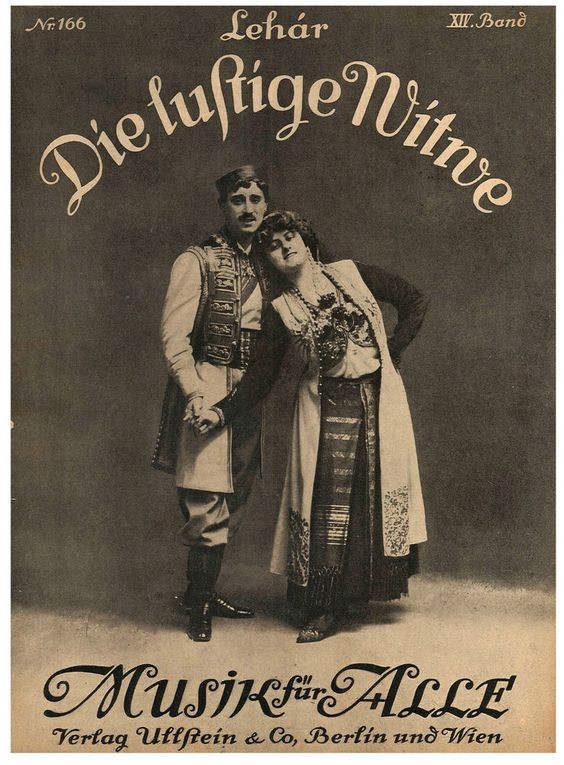
Cover of the Musik Für Alle periodical published by Ullstein Verlag with scores from The Merry Widow, /Source: www.pinterest.com
The story of the creation of the most outstanding and famous operetta composed by Ferenc Lehár – The Merry Widow is very interesting. The libretto created by Victor Leon and Leo Stein himself, was based on the comedy L'Attaché de légation by Henri Meilhac (a famous librettist who collaborated with Jacques Offenbach and Georges Bizet, the author of the opera Carmen). It tells the story of the heiress of the huge estate of Hanna Glawari, the title widow. The woman soon leaves for Paris, which she spends her dreams with the deputy of the Duchy of Ponteverdo (modelled on Montenegro) Baron Mirko Zeta. A gigantic inheritance represented the majority of the assets of the duchy and finding a husband by a widow would mean the bankruptcy of the state. The baron will do everything he can to prevent this, which starts a series of comic events. Initially, it was not Lehár who was to compose the music for the lyrics, but Richard Heuberger, the author of the operetta The Opera Ball. However, it turned out that Heuberger composes far too slowly, his works are too old-fashioned and boring, and that he was unable to convey the atmosphere of the libretto, which is why Lehár was entrusted with the mission of composing music for The Merry Widow. Soon he brought the score of his first piece, the famous duo About a foolish rider. Lehár started to write more songs with incredible speed. Work on the operetta began soon at the Theater an der Wien. The theatre directors of the time, Karl Mathias Wallner and Wilhelm Karczag, strongly criticized Lehár's works and stated that Heuberger must be brought back to the realization of the operetta because, according to them, he will not conduct unnecessary musical experiments. But Viktor Leon was tenacious and claimed that The Merry Widow with Lehár's music would have the greatest possible success. On December 30, 1905 the premiere of The Merry Widow took place, which soon achieved a staggering triumph.
https://www.youtube.com/watch?v=J1nISbmJy3I
Walc Ballsirenen oparty o melodie z Wesołej wdówki w wykonaniu Wiener Johann Strauss Orchester – dyrygent: Willi Boskovsky
The operetta conquered the stages of all the theatres in Austria-Hungary. It soon became extremely popular throughout Europe, especially in France, Italy and England (in London alone it was performed almost a thousand times). Soon afterwards, it travelled across the ocean and became a hit in the United States. The operetta conquered Russian theatres very quickly and was often performed in Moscow and St. Petersburg. Sergei Rachmaninov himself considered it to be brilliant, praising the excellent musical layer as well as the cheerful libretto. Thanks to the success of his work, Lehár became a millionaire and the whole world was humming melodies from The Merry Widow.
https://www.youtube.com/watch?v=9SKysQ6Kiek
Lips are silent, soul sings – an aria from Ferenc Lehár's The Merry Widow performed by Grażyna Brodzińska and Bogusław Morka
In 1909, an operetta, The Count of Luxembourg appeared, telling the story of an impoverished aristocrat and a beautiful opera singer, who marries on the surface without seeing the said Count and then falls in love with him at first sight unaware that they are already husband and wife. The story of its libretto is interesting. In 1897, the last operetta by Johann Strauss II, Die Göttin der Vernunft (The Goddess of Reason) premiered in Vienna. Despite the brilliant, as always, musical layer by the Waltz King (like the waltz Heut' ist heut, Op. 471 or the excellent Romantic overture), this work was not entirely successful - the background of the action (the French Revolution) was very inconsistent with the funny spirit of the work and the operetta disappeared from the poster after few performances. The libretto itself by Alfred Maria Willner, modified and transferred to contemporary Paris (1909), gave Lehar the opportunity to write excellent music. Although he was working on the Duke's Child and Gypsy Love (again with Willner's libretto), he took up this challenge and composed the music for the work in just a month (with which he was not satisfied and did not anticipate the success of the work). The operetta, written 4 years after The Merry Widow, was a great international success, as evidenced by hundreds of performances in all European capitals.
https://www.youtube.com/watch?v=NWWbJ64oeSk
Waltz based on melodies from the operetta The Count of Luxembourg performed by Wiener Johann Strauss Orchester under the baton of Willie Boskovsky
In 1910 Gypsy love was performed. The libretto of this operetta tells the story of Zorica, daughter of a rich Romanian landowner. The girl is soon to be married to the nobleman Jonel, but she falls in love with his half-brother, the gypsy violinist Józsi, who plays at their wedding party. Despite the excellent, critically acclaimed music, the operetta was not as successful as the two previous works. The main character of another operetta entitled Ewa is a simple factory worker for a change. However, the plot is stereotypical: a young son of a manufacturer falls in love with a worker - Eve and marries her after various adventures. The premiere of this definitely successful work took place in Vienna on 24 November 1911. Seventeen [FK1] years later Lehár reworked this operetta and in 1930 a new version appeared under the name World is beautiful!
https://www.youtube.com/watch?v=rfdcKP4dNfE
Waltz from Act II of Eve, operetta performed by the Hungarian National Philharmonic Orchestra and conductor János Ferencsik
It is worth mentioning that such returns to his compositions from the past are very characteristic of Lehár's work. The composer was looking for a new libretto, reworked the music and added completely new pieces. The Divine Husband, which had its premiere in 1904, was transformed into the Perfect Wife, which was performed 1913, and then 8 years later she was recast as Queen of Tango. The music from The Astronomer operetta written in 1916 was used six years later for the Dance of Libelia. This was followed by a new libretto for the operetta Yellow Jacket from 1923, creating the Land of Smile.
In 1918 the Hungarian-speaking classical operetta Skylark was staged in Budapest. The libretto was written by Hungarian Ferenc Mártos and later also translated into German. The plot of the work tells the story of a young painter, Sandor, who fell in love with his model – a charming little village of Malgosia while working on the painting in a Hungarian village. Despite the fact that the operetta had its premiere at a very difficult time for the Austro-Hungarian Monarchy, it turned out to be a great success, again mainly thanks to Lehár's music, which perfectly reflects the theme of the work (on the other hand, the libretto was heavily criticised in various reviews).
https://www.youtube.com/watch?v=l8wsj5tZgmA
Waltz based on melodies from the operetta Skylark performed by Wiener Johann Strauss Orchester under the baton of Willie Boskovsky
On 28 May 1920, a new operetta by Lehár appeared in three acts entitled the White Mazurka, in which the composer used Polish folk melodies. The libretto by Leo Stein and Béla Jenbach, although imperfect, was immediately accepted by Lehár, who was curious about the Polish theme of the text and, consequently, new compositional possibilities. The operetta describes the story of the Polish Count Julian Olinski and his freshman wife Blanka von Lossin (they met during a mazurka dance - hence the title of the work). The Countess, overhearing Julian talking to a stranger, accuses her husband of adultery and runs away from the wedding reception. The aforementioned interlocutor was Gretl Aigner, the former love of Count Olinski. The whole thing turns out to be a simple misunderstanding (Blanka heard only innocent memories of her beloved's past) and ends with the couple reuniting. Lehár once again showed his compositional genius by creating an incredibly successful score based on foreign dance musical forms, characteristic of the Polish lands. The most famous piece from the very well received by the audience and critics White Mazurka is the song Tanzt der Pole die Mazur (Pole dancing the Mazurka), maintained of course in the form of a mazurka.
https://www.youtube.com/watch?v=P9u1E0yELd8
Tanzt der Pole die Mazur from the White Mazurka performed by Anny Schlemm and Franz Fehringer
In 1922 the great Frasquita had its premiere, and two years later the cheerful Clo-Clo operetta written especially for Louise Cartouche, the famous dancer and singer from Theater an der Wien. Another interesting work is Paganini, an operetta staged in 1925, inspired by the work of a brilliant Italian violinist, which tells the story of a love affair of the same musician with Eliza Bonaparte, Napoleon's sister, the Duchess of Tuscany, Lukka and Piombino. This operetta started the composer's last, third creative phase. This phase was characterized by close cooperation with the outstanding Austrian opera tenor Richard Tauber. The audience received the work relatively well. The most successful arias from Paganini, such as Nobody loves you as I do and To have a hundred beautiful lovers, enjoyed numerous encores. This is one of the last "cheerful" operettas of the composer, who in the last stage of his career composed music to truly operatic and not very humorous librettos. Critics, praising these works, stated that Hungary should write another opera, after the already forgotten Cuckoo. Another interesting bitter-sweet operetta, i.e. The Tsarevich (1927) with Bela Jenbach's libretto, tells the story of an heir to the Russian throne who wants to marry a foreign princess. This work is very loosely based on real events - the story of Peter the Great's son Alexei and his lover Yefrosinia Fedorova. In the 1920s, several operettas were written by various composers on Russian themes. The work was well received, mainly thanks to Tauber's great performances and - as usual - great music. The best known and appreciated piece from the operetta is undoubtedly the melodious yet melancholic Volga Song.
https://www.youtube.com/watch?v=wPrykv055jA
The Volga Song performed by tenor Francisco Araiza, Stuttgarter Philharmoniker and conductor Roland Seiffarth
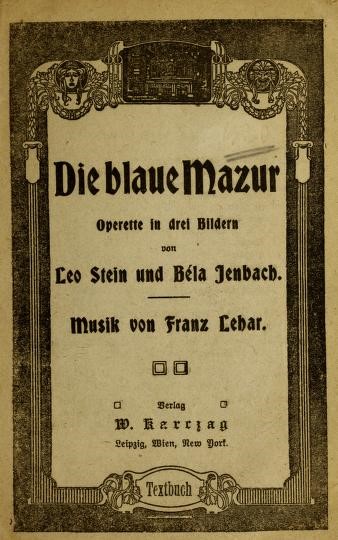
Cover of the printed edition of the libretto from the White Mazurka /Source: www.archive.org
In 1928, Friederike was performed. The protagonist of the operetta is young Goethe, and the lyrics of some of the works were written based on poems by this great poet. Lehár qualified Friederike as a singspiel, a stage piece similar to a ballad opera, with spoken lyrics and relatively simple in musical terms. The action of Friederike takes place in 1771 in the village of Sessenheim. The libretto tells the story of Goeth who, having fallen in love with the daughter of a pastor named Frederick, got engaged to her, but the girl, not wanting to interfere in the career of her beloved, leads through clever intrigue to part with the poet. Despite much more dramatic music than the earlier Lehárovské operettas, the work was very well received by the audience. Some people criticized the idea of presenting a brilliant German poet. After the National Socialist German Workers' Party seized power in Germany in 1933, an operetta was banned in that country, then it was also banned in Austria after Anschluss in 1938. The main reason for this decision of the authorities was the fact that the authors of the lyrics for the singlespiel were librettists of Jewish origin: Fritz Löhner-Beda and Ludwig Herzer.
https://www.youtube.com/watch?v=4FKqQqedZ0Q
O Mädchen, mein Mädchen (My Girlfriend) from Friederike performed by Fritz Wunderlich and Berliner Symphoniker
The last great composition by the Hungarian composer was the musical comedy Giuditta, which Lehár himself was extremely proud of. The libretto tells the story of a beautiful daughter of a Moroccan dancer who, having abandoned her husband Manuel Biffi, is hiding with Captain Octavio in North Africa. Soon, however, the said officer leaves Giuditta in connection with his duties in the army. It was a very ambitious work - it was intended for a large, larger orchestra than most Lehár's operettas and with a truly operatic libretto reminiscent of Bizet's Carmen. Despite the great initial success, Giuditta soon began to disappear from the repertoire, but the great waltz from this work and the aria My lips are so hot to kiss are appreciated by audiences to this day.
https://www.youtube.com/watch?v=ArCieiY2zzQ
Waltz from Giuditta performed by Staatskapelle Dresden under the baton of Christian Thielemann
Also worth mentioning is the opera Wandering apprentice from 1943, the last stage piece by Lehár. It was a new, revised version of Gypsy love (Zigeunerliebe) published 33 years earlier. The main character of the work is Garabonciás, a Hungarian student who is leaving school in order to organize a unit to fight in the revolution of 1848. A girl named Sarika falls in love with him, who wants to support the uprising by joining the above-mentioned insurgent unit. She changed her plans after seeing the vision in which she saw the fall of the uprising, Garabonciás' escape, and then his miserable life in hiding. During the premiere performance in Budapest, despite his age, Lehár himself conducted the orchestra. Shortly afterwards, he left for Switzerland with his wife Sophie suffering from heart related diseases, in order to provide her with the best possible medical care. Unfortunately, despite Ferenc's great efforts, she died at the end of 1947, which was the reason why Lehár returned to Austria.
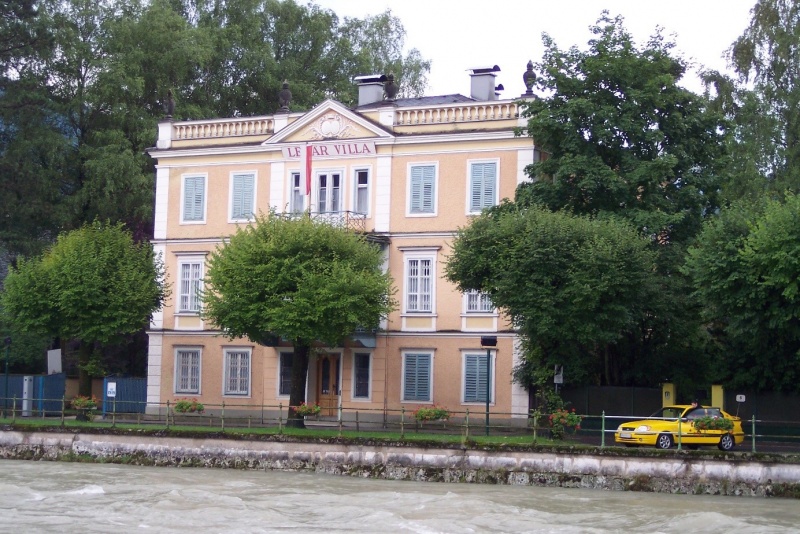
Ferenc Lehár's villa in Bad Ischl, Austria, which today serves as the composer's museum./Source: Wikimedia Commons
Ferenc Lehár died in Bad Ischl in Austria on 24 October 1948 at the age of seventy-eight. He wrote over thirty operettas and operas in different varieties of these genres, from light vaudeville to sublime and monumental opera works that Verdi himself would not be ashamed of. This Hungarian composer and conductor is one of the most outstanding operetta composers. His influence on this genre was significant to such an extent that one could be tempted to say that it created the contemporary operetta. Loved around the world, he remains one of the most popular composers. Lehár's most famous operetta, Die lustige Witwe (The Merry Widow), has given him immortality and a permanent place in the repertoire of musical theatres since its premiere in 1905. Tens of millions of records from this operetta have been sold to date.
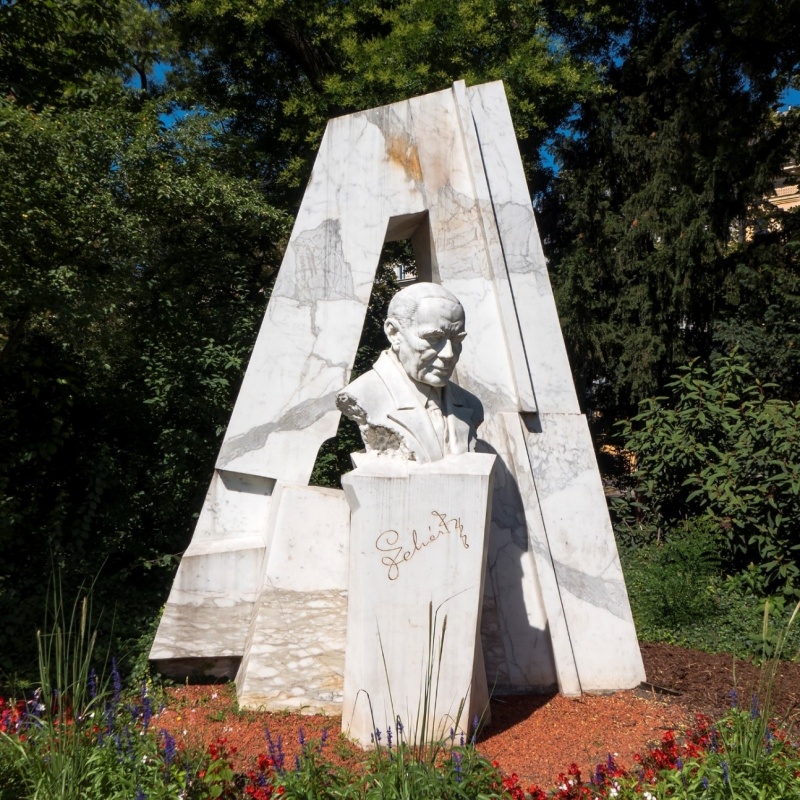
A monument to Lehár in the Viennese Stadtpark /Source: Wikimedia Commons
Adam Bielecki
Sources:
- Kydryński, L., Usta milczą dusza śpiewa. Opowieść o życiu i twórczości Franciszka Lehára. Wydawnictwo Radia i Telewizji, Warsaw 1992
- Greene, D., Greene's Biographical Encyclopedia of Composers. Garden City, Doubleday, New York 1985
- Grun, B., Dzieje operetki, Polskie Wydawnictwo Muzyczne, Kraków 1974
- Melitz, M., Przewodnik po operetkach, Wydawnictwo Globus, Berlin 1917
- Traubner, R., Operetta: A Theatrical History, Routledge, 2003
- https://imslp.org/wiki/Ungarische_Fantasie%2C_Op.45_(Leh%C3%A1r%2C_Franz)
- http://www.josefkolbe.com/military/50th-infantry-regiment
